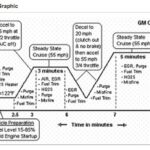For owners and enthusiasts of classic trucks like the 1991 Dodge Ram, understanding the diagnostic systems can be crucial for maintenance and repair. A common question that arises when dealing with vehicle diagnostics, especially for those familiar with modern cars, is whether a 1991 Dodge Ram has an OBD2 reader. Let’s clarify this and delve into what diagnostic capabilities this vintage truck actually possesses.
Decoding On-Board Diagnostics: OBD1 vs. OBD2
To answer the question directly, no, a 1991 Dodge Ram is not equipped with an OBD2 (On-Board Diagnostics 2nd Generation) reader. The 1991 model year predates the widespread adoption of OBD2, which became mandatory in the United States for all cars manufactured from 1996 onwards. Vehicles from 1991, including the Dodge Ram, typically utilize an earlier generation of diagnostic systems known as OBD1.
OBD1: The Precursor to Modern Diagnostics
OBD1 systems were the first attempts at standardizing automotive diagnostics. However, unlike the unified standards of OBD2, OBD1 was characterized by a lack of uniformity. Different manufacturers often used proprietary connectors, communication protocols, and even methods for retrieving diagnostic trouble codes (DTCs).
For a 1991 Dodge Ram, this means that accessing diagnostic information is different from modern OBD2-equipped vehicles. You won’t find the standardized 16-pin Data Link Connector (DLC) that is characteristic of OBD2 under the dashboard.
How to Diagnose a 1991 Dodge Ram
So, if your 1991 Dodge Ram doesn’t have OBD2, how do you diagnose potential issues? Here’s what you need to know:
-
OBD1 Connector Location: The diagnostic connector on a 1991 Dodge Ram, if present, will be an OBD1 connector. Its location can vary, but it’s often found in the engine bay or under the dashboard, although it will not resemble the OBD2 port you might be familiar with.
-
Diagnostic Trouble Codes (DTCs): OBD1 systems do store diagnostic trouble codes when issues are detected by the vehicle’s computer. However, retrieving these codes usually requires different tools and methods compared to OBD2.
-
Reading OBD1 Codes:
- OBD1 Scan Tools: While not as universally available as OBD2 scanners, OBD1 scan tools do exist. You would need a scan tool specifically designed for OBD1 systems and potentially for Chrysler/Dodge vehicles of that era to read the codes.
- Key Cycling Method: Some OBD1 systems, including certain Chrysler vehicles of the time, allowed for code retrieval through a “key cycling” method. This involves turning the ignition key on and off in a specific sequence to make the “Check Engine” light blink in patterns that represent the diagnostic codes. You would then need a reference chart to interpret these blink codes.
- Voltmeter/Test Light: In some cases, a voltmeter or test light could be used in conjunction with the diagnostic connector to read codes, again requiring specific procedures and code charts.
-
Interpreting Codes: Once you retrieve the codes, you will need an OBD1 code chart specific to Dodge or Chrysler vehicles of 1991 to understand what each code signifies. These charts are available in repair manuals and sometimes online resources dedicated to older vehicle diagnostics.
The Evolution to OBD2 and Modern Diagnostics
The transition from OBD1 to OBD2 was driven by the need for greater standardization and enhanced emissions control. OBD2 provided:
- Standardized Connector: The 16-pin DLC is universal across all OBD2 compliant vehicles, making it easy to connect scan tools.
- Standardized Codes (SAE J1979): A standardized set of diagnostic trouble codes and parameters, simplifying diagnostics across different makes and models.
- Enhanced Diagnostic Capabilities: OBD2 systems monitor a wider range of emissions-related components and systems, providing more detailed diagnostic information.
- Readiness Monitors: OBD2 introduced readiness monitors, self-tests that the vehicle performs to ensure emission control systems are functioning correctly, as detailed in the original article you provided.
The original article, “On-Board Diagnostic Test Reference,” while not directly about a 1991 Dodge Ram, is highly relevant as it discusses OBD test standards, particularly for Smog Check inspections. It highlights the importance of OBD systems in verifying emission control functionality and outlines pass/fail criteria, readiness monitor standards, and communication protocols for OBD2 systems. Although the 1991 Dodge Ram uses an earlier system, understanding the principles of OBD and its evolution to OBD2 provides valuable context for anyone working on vehicle diagnostics, whether for classic trucks or modern cars.
Conclusion: Diagnosing Your Classic 1991 Dodge Ram
While a 1991 Dodge Ram does not have an OBD2 reader, it does have its own diagnostic system (OBD1 or a precursor) that can be used to troubleshoot issues. Diagnosing it requires different tools and knowledge compared to OBD2 vehicles. Understanding the distinction between OBD1 and OBD2 is essential for anyone working on vehicles from different eras. For your 1991 Dodge Ram, you’ll need to familiarize yourself with OBD1 diagnostic methods or consult repair professionals who specialize in older vehicles to effectively read and interpret any diagnostic codes your truck may be storing.
For further in-depth information on OBD testing standards and procedures, especially as they relate to emissions inspections, refer to resources like the original article provided, keeping in mind that it primarily focuses on OBD2 and later systems.
Disclaimer: Always consult your vehicle’s repair manual and qualified automotive technicians for accurate diagnostic and repair procedures.
